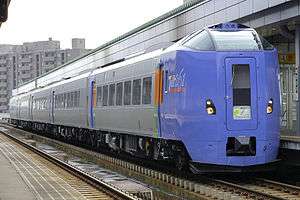Tokachi (train)
The Super Tokachi (スーパーとかち) is a limited express train service between Sapporo and Obihiro via the Hakodate and Nemuro Main Lines in Hokkaido, Japan, operated by Hokkaido Railway Company (JR Hokkaido). As of November 2013, there are five trains per day running in both directions, with the fastest journey taking 2 hours 25 minutes (Super Tokachi 4).[2]
 KiHa 261-1000 series DMU on a Super Tokachi service at Obihiro Station, October 2007 | |
| Overview | |
|---|---|
| Service type | Limited express |
| Status | Operational |
| Locale | Hokkaido |
| First service | 1 February 1962 (Express) 1 September 1990 (Limited express) 27 July 1991 (Super Tokachi) |
| Current operator(s) | JR Hokkaido |
| Former operator(s) | JNR |
| Route | |
| Start | Sapporo |
| End | Obihiro |
| Distance travelled | 136.8 mi (220.2 km) |
| Average journey time | 2 hours 30 minutes approx |
| Service frequency | 5 return services daily |
| On-board services | |
| Class(es) | Standard + Green |
| Catering facilities | None |
| Other facilities | Toilet |
| Technical | |
| Rolling stock | KiHa 261 series, KiHa 283 series DMUs |
| Track gauge | 1,067 mm (3 ft 6 in) |
| Electrification | Diesel |
| Operating speed | 120 km/h (75 mph)[1] |
Rolling stock
Super Tokachi services are formed of 4-car (originally 5-car) KiHa 261 series and 5-car KiHa 283 series diesel multiple unit (DMU) trains.[3]
Formations
All cars are no-smoking.
KiHa 261 series
| Car No. | 1 | 2 | 3 | 4 |
|---|---|---|---|---|
| Accommodation | Green | Reserved | Reserved | Non-reserved |
KiHa 283 series (Past)
| Car No. | 1 | 2 | 3 | 4 | 5 |
|---|---|---|---|---|---|
| Accommodation | Green | Reserved | Reserved | Non-reserved | Non-reserved |
Past
 KiHa 183 series Tokachi service, September 1990
KiHa 183 series Tokachi service, September 1990 KiHa 183 series Super Tokachi service, 1993
KiHa 183 series Super Tokachi service, 1993 KiHa 183 series Tokachi service, August 2009
KiHa 183 series Tokachi service, August 2009
History
The service commenced as the express Tokachi (十勝) on 1 February 1962, operating between Sapporo and Obihiro. The service continued until 30 September 1968.[4]
The name was revived from 1 September 1990 as the Limited express Tokachi (とかち) using KiHa 183 series DMUs. From 27 July 1991, four Tokachi services were upgraded to become Super Tokachi using KiHa 183 series DMU sets including bilevel Green cars.[4]
From 1 October 2007, new 5-car KiHa 261-1000 series tilting DMUs were introduced on Super Tokachi services, with KiHa 283 series tilting DMUs also used on some services.[1]
From 1 October 2009, the remaining two Tokachi return services daily were upgraded to Super Tokachi using KiHa 261-1000 series DMUs.[5]
Future plans
From 1 November 2014, the refreshment trolley service and Green car complimentary drink service are discontinued, with refreshments sold instead in car 1. Refreshment service was scheduled to be discontinued entirely from 1 January 2015.
References
- JR新幹線&特急列車ファイル [JR Shinkansen & Limited Express Train File]. Japan: Kōtsū Shimbun. 2008. p. 114. ISBN 978-4-330-00608-6.
- JR Timetable, October 2009 issue
- 特急スーパーとかち(261系・283系) 列車ガイド [Super Tokachi (261/283 series) Train guide] (in Japanese). Japan: Hokkaido Railway Company. 21 July 2011. Retrieved 23 February 2012.
- 列車名鑑1995 [Train Name Directory 1995]. Japan: Railway Journal. August 1995. p. 127.
- Rail Magazine: キハ183系特急〈とかち〉消滅 (KiHa 183 series Tokachi disappear) (1 October 2009). Retrieved on 1 October 2009. (in Japanese)
External links
| Wikimedia Commons has media related to Tokachi (train). |
- JR Hokkaido Super Tokachi train information (in Japanese)